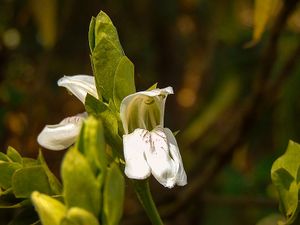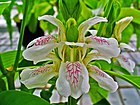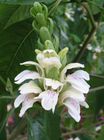Note: This is a project under development. The articles on this wiki are just being initiated and broadly incomplete. You can Help creating new pages.
Justicia Adhatoda - Sinhapuri
Justicia Adhatoda plant is very useful in Indian Ayurveda. It is a medicinal plant native to asia , widely used in siddha medicine, ayurvedic, and homeopathy.
Uses
Asthma, Rheumatic pain, Snakebites, Excessive Bleeding, Indigestion, Bleeding Gums, Cough, Phlegm in Adults, Sore throats
Parts Used
Chemical Composition
Contains volatile oils, flavonoids, apigenin, luteolin, quercetin, kaempferol, tiliroside, triterpene glycosides including euscapic acid and tormentic acid, phenolic acids, and 3%–21% tannins[1]
Common names
| Language | Common name |
|---|---|
| Kannada | Adusoge |
| Hindi | Vasika |
| Malayalam | Atalotakam |
| Tamil | Adadorai, Arathorai |
| Telugu | Adasaramu |
| Marathi | NA |
| Gujarathi | NA |
| Punjabi | NA |
| Kashmiri | NA |
| Sanskrit | Vasaka |
| English | Malabar nut |
Properties
Reference: Dravya - Substance, Rasa - Taste, Guna - Qualities, Veerya - Potency, Vipaka - Post-digesion effect, Karma - Pharmacological activity, Prabhava - Therepeutics.
Dravya
Rasa
Tikta (Bitter), Kashaya (Astringent)
Guna
Laghu (Light), Ruksha (Dry)
Veerya
Sheeta (cold)
Vipaka
Katu (Pungent)
Karma
Kapha, Pitta
Prabhava
Habit
Identification
Leaf
| Kind | Shape | Feature |
|---|---|---|
| Simple | lanceolate | Slightly acuminate, base tapering, petiolate, petioles 2-8 cm long, exstipulite |
Flower
| Type | Size | Color and composition | Stamen | More information |
|---|---|---|---|---|
| Unisexual | 2-4cm long | Yellow | 5 | It is dense short-pendunculate, bracteate with terminal spike |
Fruit
| Type | Size | Mass | Appearance | Seeds | More information |
|---|---|---|---|---|---|
| simple | 7–10 mm | The fruit is a small capsule | many | {{{6}}} |
Other features
List of Ayurvedic medicine in which the herb is used
- Vishatinduka Taila as root juice extract
Where to get the saplings
Mode of Propagation
How to plant/cultivate
Adathoda vasica N. is an evergreen shrub with unpleasant, foetid smell. The older stem is greyish green, warty and woody.[3]
Commonly seen growing in areas
Photo Gallery
References
External Links
- Ayurvedic Herbs known to be helpful to treat Asthma
- Ayurvedic Herbs known to be helpful to treat Rheumatic pain
- Ayurvedic Herbs known to be helpful to treat Snakebites
- Ayurvedic Herbs known to be helpful to treat Excessive Bleeding
- Ayurvedic Herbs known to be helpful to treat Indigestion
- Ayurvedic Herbs known to be helpful to treat Bleeding Gums
- Ayurvedic Herbs known to be helpful to treat Cough
- Ayurvedic Herbs known to be helpful to treat Phlegm in Adults
- Ayurvedic Herbs known to be helpful to treat Sore throats
- Herbs with Leaves used in medicine
- Herbs with Roots used in medicine
- Herbs with Bark used in medicine
- Herbs with common name in Kannada
- Herbs with common name in Hindi
- Herbs with common name in Malayalam
- Herbs with common name in Tamil
- Herbs with common name in Telugu
- Herbs with common name in Sanskrit
- Herbs with common name in English
- Habit - Shrub
- Index of Plants which can be propagated by Seeds
- Index of Plants which can be propagated by Cuttings
- Herbs that are commonly seen in the region of Lower Himalayans
- Herbs that are commonly seen in the region of Tropical areas
- Herbs that are commonly seen in the region of Moisture areas
- Herbs that are commonly seen in the region of Dry soils
- Herbs




